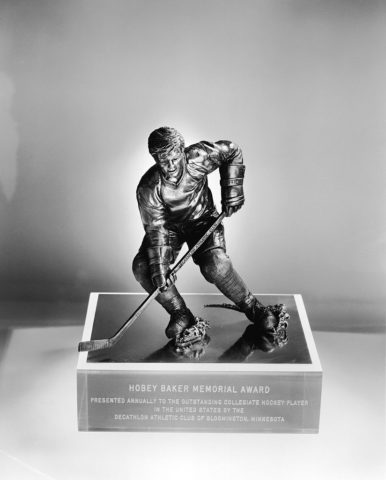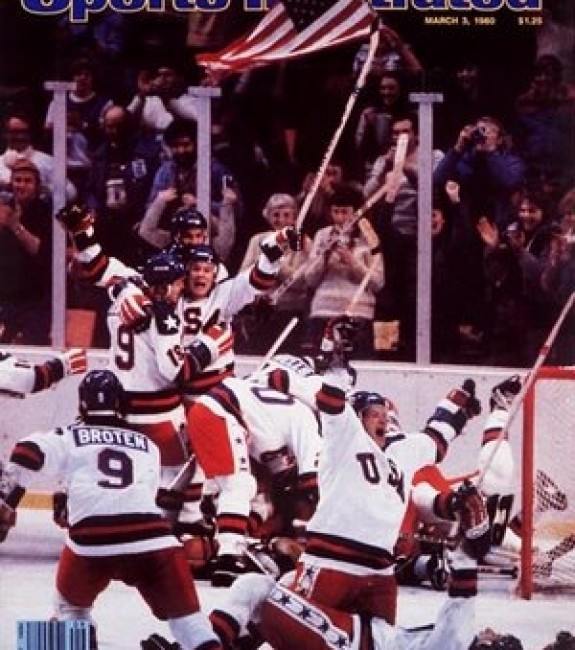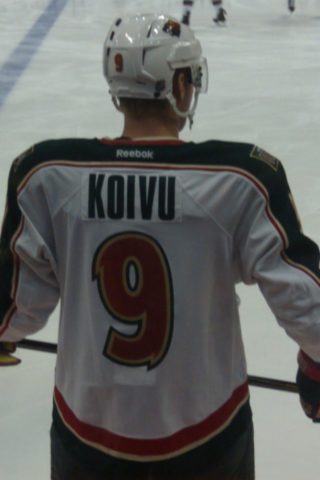Hockey and military service have been closely linked since the early precursors of the modern game we all know and love. While attempting to commemorate every hockey player who has ever served their country in a military uniform would be as fruitless as The Charge of the Light Brigade, a rather comprehensive list of players who served does exist. However, on this Veterans Day, my aim is to merely highlight the coexistence of hockey and military service from a few different perspectives and in a few different time periods, from the ghastly trenches of WWI to today’s endless Global War on Terror.
World War I
Aside from regional conflicts such as the American Civil War or the Crimean War, WWI is arguably the oldest war that a majority of people around the globe can at least distantly relate to. “The Great War” is ultimately responsible for, and directly tied to, US collegiate hockey’s most prestigious honor — the Hobey Baker Memorial Award.

In the early days of hockey when the “rover” position existed, Hobey Baker rose to prominence as a record-setting member of Princeton University’s hockey club. Instead of pursuing a promising professional career, Baker heeded his nation’s call to serve. Joining the U.S. contingent of pilots under the French Lafayette Escadrille — prior to even the earliest precursors of the US Air Force — Baker distinguished himself as an exceptional combat pilot. Unfortunately, his luck ran out just before returning home, as his plane crashed returning from an ill-advised “last flight.”
Many more Canadian players, such as legend Frank McGee, also perished in the gruesome battles of the First World War. It was a bleak time in human history, but I’d like to think that the decision to thrust themselves into harm’s way says a great deal about the character of the men who laced up skates during that time.
World War II
World War II was yet another platform for hockey players to demonstrate the toughness and grit they are renowned for. In fact, players like Harry Torgerson arguably had a bigger impact on the battlefield than they ever did on a sheet of ice. In several eyewitness accounts, Torgerson (a defenseman for the Metropolitan League’s New York Stock Exchange Brokers) almost single-handedly thwarted two different Japanese assaults in the Allied victory at Guadalcanal. His efforts earned him the Silver Star and Purple Heart.
Even Conn Smythe, already a WWI veteran, served and was wounded in the Second World War. Another WWI hero, Red Dutton, did his part to keep morale high back in the U.S. and Canada by working to keep the NHL active despite the lack of talented players who were all shipping out to fight overseas.
The Cold War
After playing a big part in the Allied defeat of Germany, the Soviet Union began a rapid ascension to prominence in athletics, especially hockey. With most conflict occurring through proxy conflicts, the USSR funneled a great deal of money and resources through its military to develop world-class sports teams. Dubbed “The Red Army,” Soviet hockey teams dominated the international hockey scene from the 1960s through the ’80s despite the thrilling 1980 loss to the US Men’s Olympic team at Lake Placid.

These teams even went toe-to-toe with the best of the NHL, which at that time included both Wayne Gretzky and Mario Lemieux, and were every bit their equal. As the Cold War drew to a close, Soviet players (who could be considered mere pawns in the USSR’s military-political agenda) became trailblazers for the eventual influx of NHL players from their respective Eastern European home countries.
One could even contend that the Soviet Union’s method of allowing athletes to “serve” just by playing their sport was an inspiration for the US Army’s current World Class Athlete Program, which is a military unit whose sole purpose is to allow servicemembers to prepare for Olympic-level competition in a number of different sports.
Global War on Terror
Gone are the days of NHL players marching off to war, or a potential NHL superstar spurning a professional career to serve their country. But that does not mean hockey and military service have parted ways. In fact, several European NHLers, such as Mikko Koivu, Jussi Jokinen, and Olli Maatta have all complied with their native Finland’s mandatory military service requirements.

In the U.S. and Canada, there are a handful of admirable players who all but deny themselves an opportunity to advance their hockey careers beyond the collegiate levels by deciding to attend a service academy. Canada’s Royal Military College fields a varsity hockey team that has one of the longest and storied rivalries in collegiate sports (dating back to 1921) with the US Military Academy’s NCAA D1 hockey team.
Colloquially referred to as “Army” (or “Army West Point” since their rebrand), the US Military Academy at West Point has the solemn distinction of having the most recent “elite players” perish on the battlefield. MAJ Thomas Kennedy (USMA 2000) and 1LT Derek Hines (USMA 2003), both Army hockey players, were killed in action in the Global War on Terror in Afghanistan.
As a 2016 West Point graduate myself, it’s an honor to be connected with the likes of Kennedy and Hines, and I’m proud to have played on Army’s ACHA D2 hockey team and played a part in Army/Navy rivalry history. While I am biased, I’d be remiss if I did not mention the US Air Force Academy’s NCAA D1 and ACHA D3 teams. The US Naval Academy also fields an ACHA D1 and D2 team.
Like any other violent contact sport, I think it’s safe to say that hockey and military service will continue to remain close and connected. There’s a quote by Gen. Douglas MacArthur that is required knowledge at West Point:
Upon the fields of friendly strife are sown the seeds that on other days, on other fields, will bear the fruits of victory.
Gen. Douglas MacArthur
The toughness, grit, and teamwork that are essential to being a good hockey player are the same desirable qualities for serving in the military. Although Veterans Day 2019 is in the rear-view mirror, I’d encourage you to ask about and listen to a veteran’s story if you’re close to one. Who knows, maybe they’ve got a good hockey story, as well?